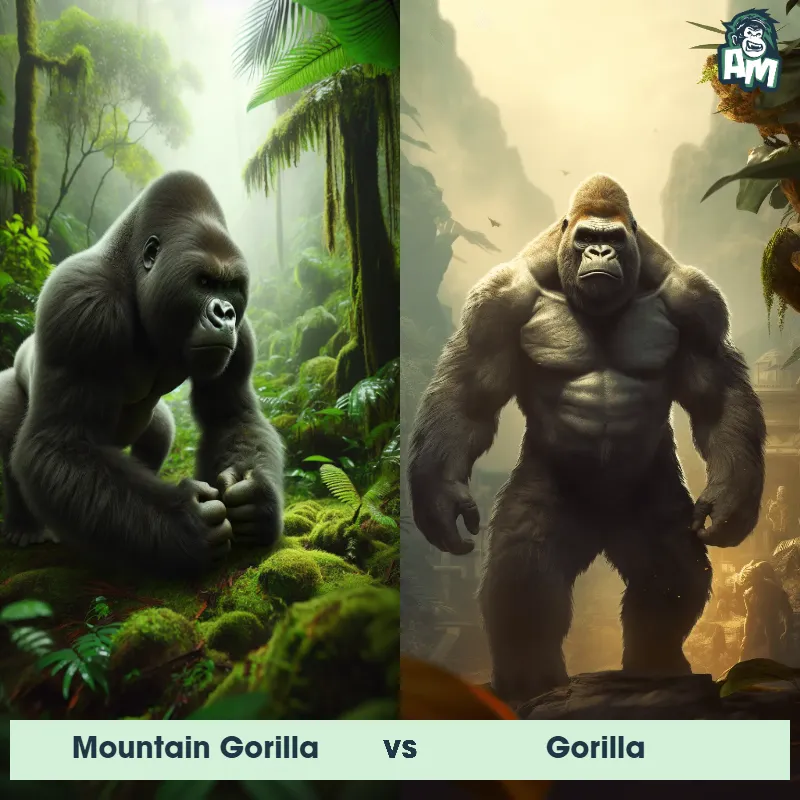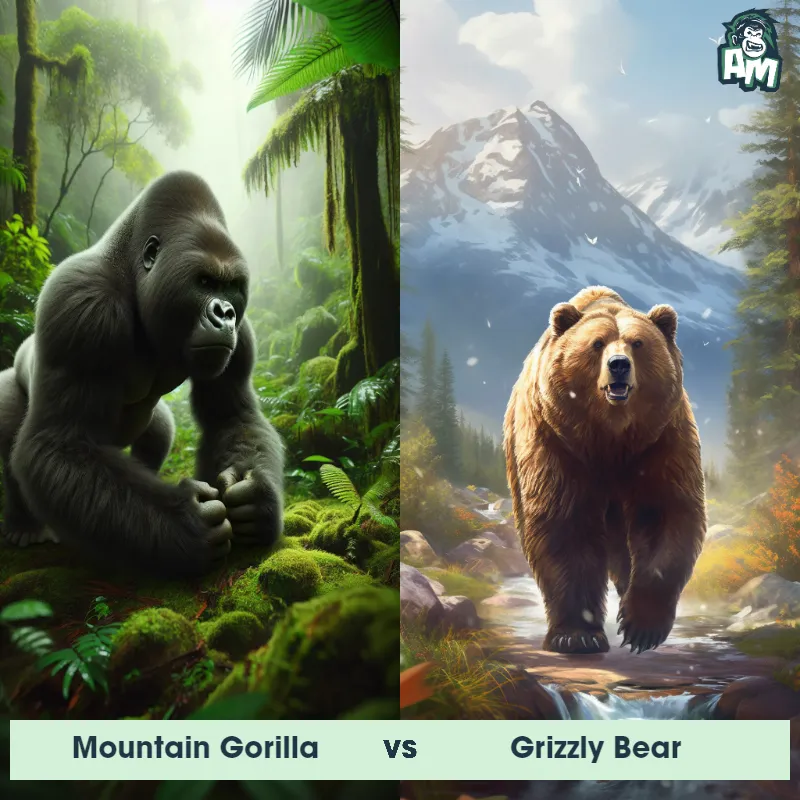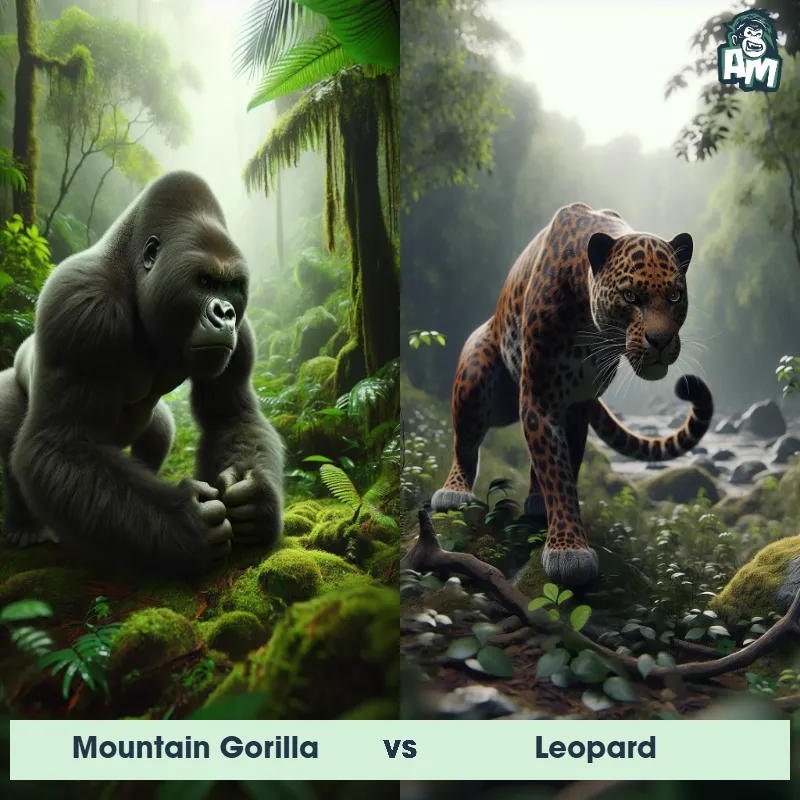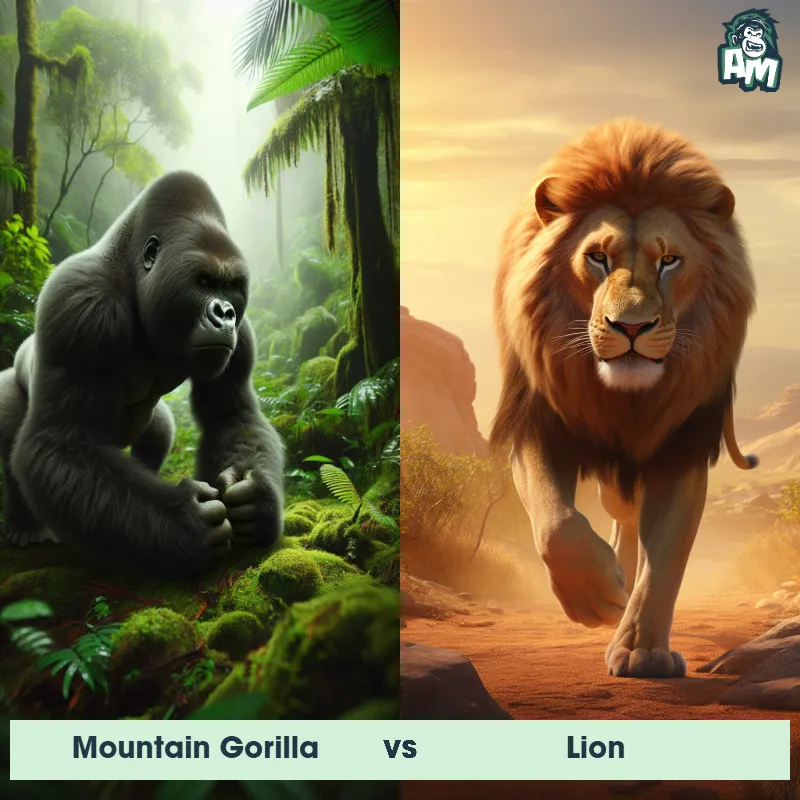The Mountain Gorilla
The Mountain Gorilla is a large, powerful primate found in the dense forests of central Africa. They are known for their striking appearance, with a muscular build, long arms, and a thick black fur that helps them withstand the cold temperatures in their mountainous habitat. They have broad, powerful chests and large heads, adorned with a prominent sagittal crest on top. Mountain gorillas are herbivorous and primarily feed on a variety of plant materials such as leaves, shoots, and fruits. They are highly intelligent and live in social groups called troops, led by a dominant silverback male.

| Mountain Gorilla | |
|---|---|
| Size | Up to 6 feet (1.8 meters) tall |
| Weight | Around 400 pounds (180 kilograms) |
| Speed | 25mph (40km/h) |
| Key Strength | Powerful upper body |
| Biggest Weakness | Vulnerable head |
| Scientific Name | Gorilla beringei beringei |
| Family | Hominidae |
| Habitat | Mountain forests |
| Geography | East Africa (Virunga Massif) |
| Diet | Herbivorous |
| Lifespan | 30 years - 40 years |

The Mountain Gorilla
The Mountain Gorilla is a large, powerful primate found in the dense forests of central Africa. They are known for their striking appearance, with a muscular build, long arms, and a thick black fur that helps them withstand the cold temperatures in their mountainous habitat. They have broad, powerful chests and large heads, adorned with a prominent sagittal crest on top. Mountain gorillas are herbivorous and primarily feed on a variety of plant materials such as leaves, shoots, and fruits. They are highly intelligent and live in social groups called troops, led by a dominant silverback male.
Fun Fact: One fascinating fact about Mountain Gorillas is that they are the largest primates on land, with adult males weighing up to 400 pounds and standing up to 5.6 feet tall when fully erect.
| Mountain Gorilla | |
|---|---|
| Size | Up to 6 feet (1.8 meters) tall |
| Weight | Around 400 pounds (180 kilograms) |
| Speed | 25mph (40km/h) |
| Key Strength | Powerful upper body |
| Biggest Weakness | Vulnerable head |
| Scientific Name | Gorilla beringei beringei |
| Family | Hominidae |
| Habitat | Mountain forests |
| Geography | East Africa (Virunga Massif) |
| Diet | Herbivorous |
| Lifespan | 30 years - 40 years |
Mountain Gorilla Matchups
We use AI to simulate matchups between the Mountain Gorilla and other animals. Our simulation considers size, strength, and natural predatory behaviors to determine the most likely outcome.
Mountain Gorilla: Diet, Predators, Aggression, and Defensive Behaviors
What do Mountain Gorillas eat?
Mountain Gorillas are primarily herbivores, with a diet consisting mainly of leaves, shoots, fruits, and occasionally insects. They spend a significant portion of their day foraging for food in order to meet their daily nutritional requirements.
Do Mountain Gorillas have any predators?
While Mountain Gorillas are incredibly strong and have no natural predators in their habitat, humans pose the biggest threat to their survival. Illegal poaching, habitat destruction, and human encroachment are the main factors contributing to the decline in Mountain Gorilla populations.
Are Mountain Gorillas aggressive?
Mountain Gorillas are generally peaceful and non-aggressive animals. They live in tight-knit social groups led by a dominant male, known as a silverback, whose role is to protect and maintain order within the group. However, they can become aggressive when threatened or during territorial disputes.
Do Mountain Gorillas fight with each other?
Mountain Gorillas rarely engage in physical fights with members of their own group. Instead, conflicts are usually resolved through displays of dominance, vocalizations, and posturing. Physical fights most commonly occur between rival males competing for dominance or breeding rights.
How do Mountain Gorillas defend themselves?
Mountain Gorillas have several methods of defending themselves against threats. They rely on their size and strength to intimidate predators or potential threats. Additionally, they may use vocalizations, charging, or chest-beating displays to deter any perceived danger.
What is the biggest weakness of Mountain Gorillas in a fight?
Despite their formidable size and strength, Mountain Gorillas' biggest weakness in a fight is likely their vulnerability to human interference. Habitat destruction, poaching, and disease spread by humans pose significant threats to their survival and ability to defend themselves in the wild.
Fun Fact: Unlike most other primates, Mountain Gorillas construct nests to sleep in every night by bending and weaving together branches and foliage, displaying their impressive ability to use tools.
Fun Fact: Mountain Gorillas exhibit strong familial bonds and have a complex social structure within their troops. The silverback male, named after the silver fur on its back, leads the troop and provides protection for its members, including females and their offspring.
















